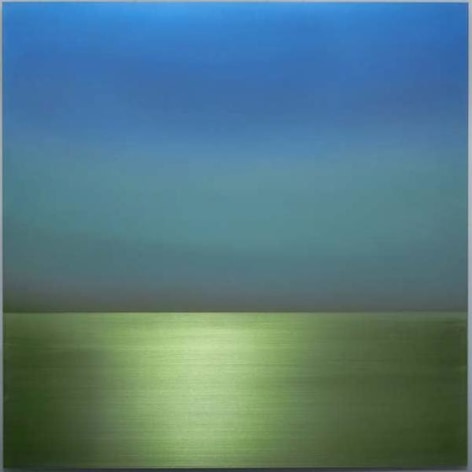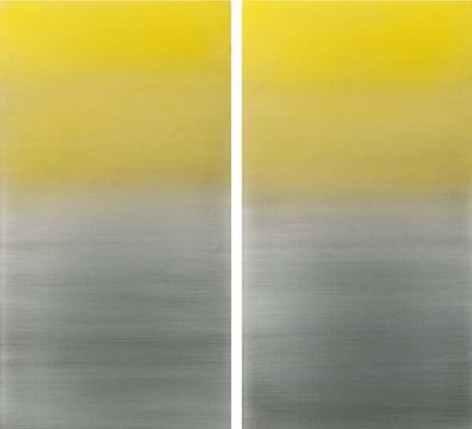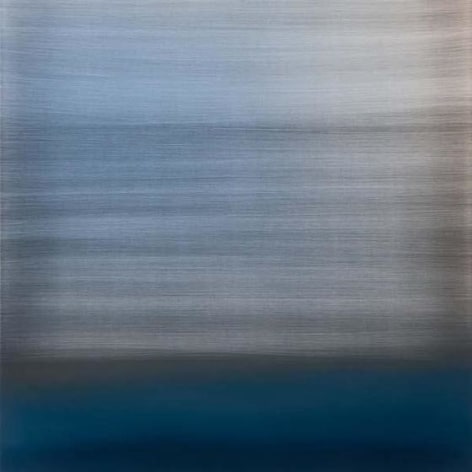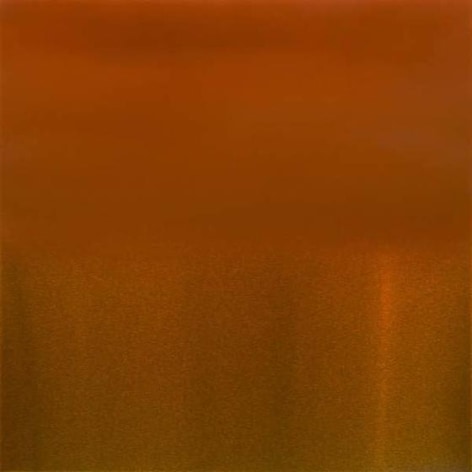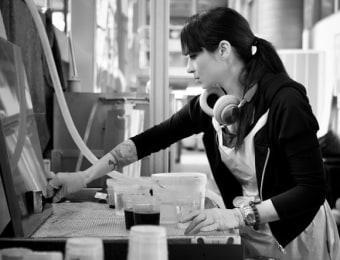
Sundaram Tagore Galleries in Hong Kong and Singapore are pleased to present a dual exhibition of recent paintings by New York artist Miya Ando. The exhibition will take place concurrently at both galleries, with each location showcasing different work.
A descendant of Bizen sword makers, Ando spent her childhood among Buddhist priests in a temple in Okayama, Japan, and later, in California. Combining traditional techniques of her ancestry with modern industrial technology, Ando skillfully transforms sheets of metal into ephemeral, abstract paintings suffused with color. The artist produced more than ninety new works for these exhibitions, ranging in size from 30 x 30 cm to 182 x 137 cm.
The Hong Kong portion of the exhibition runs from September 23 to October 30.
The foundation of Ando’s practice is the transformation of surfaces. She alters a metal’s properties by applying heat, sandpaper, grinders, pigments and chemical substances to produce subtle, light-reflective gradations of texture and color.
Ando’s new paintings are shades of vivid blue, pink, green, gray, orange and gold. It is a palette inspired by nature, which she conjures from a limited selection of industrial pigments and dyes. Combining pigment and urethane, she applies the mixture with a brush to the metal canvas in a layered process. This allows for variations of hue and finish, with some areas of the painting matte and others glossy. To produce a high-gloss finish, she adds additional layers of urethane and resin, which vividly amplify the reflective quality of the metal. Often Ando will subtract layers by sanding and grinding in order to achieve the desired finish. The resulting works subtly evoke ethereal, minimalist landscapes, cloud formations and abstracted metallic horizons.
Ando’s goal has always been to create a relationship between her industrial materials and the natural world. This paradoxical pairing is intentional. Not only is it a way for the artist, who is highly attuned to nature, to connect with her heritage, but it is also an exploration of impermanence and the passage of time. Ando attributes the Buddhist notion of ku (emptiness) to her paintings before viewer interaction occurs. Viewers counter the notion of ku and complete the painting when they become aware of the fleetingness of time embodied in the gradations of form and color that occur with the shifting of light over the course of the day and the passage of the seasons.
The artist’s use of color also determines the viewer experience. Ando perceives color as light moving at different frequencies. She plays upon this by employing glossy and matte finishes, as well as mineral dust, and contrasting color with glimpses of the metal canvas. The results can be translucent yet opaque, creating a juxtaposition that draws attention to transient moments captured in the painting.
For her exhibition at Sundaram Tagore Singapore, Ando continues the exploration of a relatively new material in her practice: shou sugi ban, a charred wood used as an exterior building material in her hometown of Okayama. Similar to the metal she uses, the wood, once charred, is transformed, becoming stronger and more durable. Her 1.9-by-1.9-meter installation Emptiness the Sky (Shou Sugi Ban) 2 is constructed with four walls clad in this material. On one wall is a small door, a nijiriguchi, a typical architectural element in Japanese chado (tea-ceremony houses). Teahouses are traditionally spaces without hierarchy or elitism and thus the nijiriguchi requires all who enter to bow their heads (traditionally, this included even Samurais, who also had to remove their sword, a symbol of rank, in order to enter). The interior of the sculpture offers a quiet space for contemplation and the experience of stepping inside one of Ando’s metal paintings.
The artist’s second installation Fuji (Wisteria) Forest is composed of hundreds of cascading Bodhi leaves in gradients of purple, alluding to the artist’s heritage. The name Ando translates as “peaceful wisteria” and purple is the color of the wisteria flower. The 1.6-meter-tall installation also references momiji-gari, the Japanese tradition of traveling to scenic areas to view autumn leaves. Although it is considered a secular event, there is a spiritual element, as viewers are reminded that all things are transitory and that these transformations, cyclical and otherwise, mark time.
A small selection of earlier paintings on anodized aluminum, in which sapphire crystals are electroplated to the metal, will also be on view.
Miya Ando has a Bachelor of Arts degree in East Asian Studies from the University of California, Berkeley, and attended Yale University to study Buddhist iconography and imagery. She apprenticed with a master metalsmith in Japan followed by a residency at Northern California’s Public Art Academy. Her work has been shown worldwide, including in a show curated by Nat Trotman of the Guggenheim Museum and an exhibition at the Queens Museum, New York. A large installation is currently on view in Frontiers Reimagined, a collateral event of the 56th Venice Biennale (www.frontiersreimagined.org).
Miya Ando has produced numerous public commissions, most notably a thirty-foot-tall sculpture in London built from World Trade Center steel to mark the ten-year anniversary of 9/11, for which she was recently nominated for a DARC Award in Best Light Art Installation. Awards include the Pollock-Krasner Foundation Grant, 2012. She lives and works in New York.
For more information email singapore@sundaramtagore.com or call +65 6694 3378.

